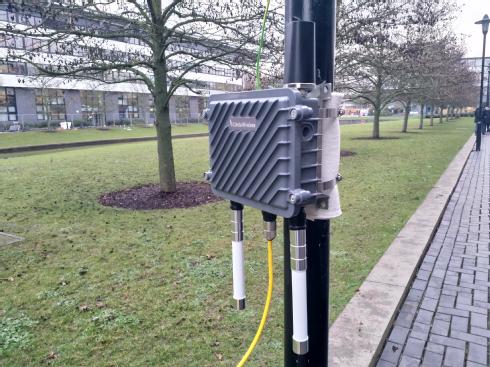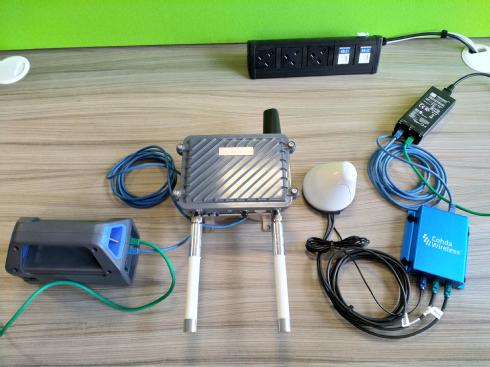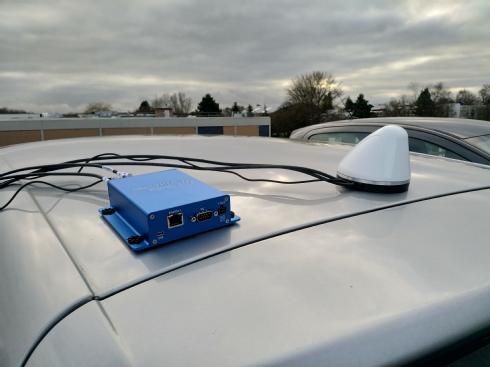Cyber security of Connected Autonomous Vehicles trialled
- The security, privacy and safety of connected autonomous vehicles (CAVs) has been improved thanks to testing at WMG, University of Warwick.
- WMG undertook real-world testing of four innovations in the IoT-enabled Transport and Mobility Demonstrator.
- They were able to connect CAVs to other CAVs and roadside infrastructure more securely and privately.

The privacy and security of data in CAVs has been improved thanks to WMG, University of Warwick who tested four innovations that were results of the PETRAS project. CAVs can now connect to each other, roadside infrastructure, and roadside infrastructure to each other more securely.
In the near future Connected and Autonomous Vehicles are expected to become widely used across the UK. To ensure a smooth deployment, researchers from WMG, University of Warwick undertook real-world testing of four academic innovations in the IoT-enabled Transport and Mobility Demonstrator project funded by Lloyd’s Register Foundation.
The testing looked at how the vehicles will connect to each other, as well as to roadside infrastructure, and the roadside infrastructures to each other.
The four innovations tested were developed within the PETRAS Internet of Things Research Hub and aimed to improve the security, privacy and safety of future connected vehicles.
The four new innovations included:
- Group Signatures:

For a vehicle to communicate it is important that the messages it sends contain a proof that the vehicle is who they claim to be (via a digital signature). However, by revealing and proving the vehicle’s identity it allows that vehicle to be tracked over a long time. In order to provide privacy a group signature can be used, which only indicates that the vehicle is a member of a group.
The group signature scheme can be extended to use a timestamp that updates every 10 minutes as a component of the signature. Therefore, if the vehicle was to send the exact same message at 10:00am and 10:10am the group signature would differ and an eavesdropper would not be able link that the vehicle sent both messages. This scheme would be useful in vehicle platooning where vehicles want to demonstrate they are part of the platoon group.
- Authentication Prioritisation:
It is an expensive task for a vehicle to verify another’s identity. Vehicles will have limited computing resources and so will only be able to verify a specific number of identities included in messages per second. For example, if a vehicle is on a busy motorway in traffic there may already be more vehicles sending messages that can be verified in a timely manner. An adversary may also try to send many messages with incorrect signatures in order to prevent vehicles from verifying the identity of actual vehicles. Therefore the order in which the identity of messages are verified is decided based on assigning a priority to the messages. A higher priority means that those messages have the identity of the sender verified first.
- Decentralised PKI:

When a vehicle is travelling down a road it may meet multiple vehicles in a short space of time. In order to check the identity of these vehicles, the public key of the other vehicle needs to be downloaded from a keyserver. However, hosting this keyserver in the cloud has limitations due to additional communication hops increasing the time before the vehicle receives the necessary keys. Instead, vehicles can receive these keys faster if the keysever is distributed over Edge infrastructure that sits next to the road.
- Decentralised PKI with Pseudonyms:
This innovation extended the previous innovation to support periodically issuing new identities to vehicles on the road to provide privacy. Both this innovation and group signatures may be required, as they are useful in different scenarios.
Each of the techniques above were demonstrated in the real world on the campuses of the Universities of Warwick and Surrey, as well as Millbrook Proving Ground.
A follow up executive summary, informed through feedback when the work was presented at the House of Lords, is now available. The summary makes a number of recommendations, including more communication infrastructure should be deployed, and that researchers should have an ability test different types of cyberattacks on CAVs and roadside infrastructure. 5G should also be used to perform the testing, as 5G is being rolled out across the UK in the future.
Lead of the project Professor Carsten Maple of WMG, University of Warwick comments:
“The cyber-security of CAVs is key to make sure that when the vehicles are on the roads, the data is trustworthy and that vehicle communications do not compromise privacy. We tested four innovations developed in the PETRAS Project, and being able to apply them to the real world is the first major step in testing security of CAV systems.
“The units being investigated to be used in cars and on the roadside were taken to Parliament in February to demonstrate how they work; now we can focus on further testing in the real world. Future work include will include testing on 5G systems, and with different types of attacks”.
ENDS
- NOTES TO EDITORS
High-res images available at:
Introductory video available at:
https://www.youtube.com/watch?v=RuHrKTf_cdM&feature=youtu.be
Other videos available at:
https://www.youtube.com/watch?v=klmR3klacEU&feature=youtu.be
https://www.youtube.com/watch?v=zmGN_aZrULo&feature=youtu.be
Further information;
There are a series of videos available with Prof Carsten Maple which are industry / tech focused, and a more generic video which introduces the video and is appropriate for general public.
https://www.petrashub.org/about/
https://www.petrashub.org/petras-nce/about/
· The PETRAS Internet of Things Research Hub is a consortium of eleven leading UK universities which worked together between 2016 and 2019 to explore critical issues in privacy, ethics, trust, reliability, acceptability, and security.
· Funding for the Hub included a £9.7 million grant from the Engineering and Physical Sciences Research Council (EPSRC) which was boosted by partner contributions to approximately £23 million in total.
· The project also ran in collaboration with IoTUK.
· The PETRAS Research Hub is now being followed up with the PETRAS National Centre of Excellence for IoT Systems Cybersecurity.
· https://www.lrfoundation.org.uk/en/about-us/
WMG worked with:
University of Surrey
Ordnance Survey
Costain
Meridian
Network Rail
Honda
TUV-SUD
BT
Contact:
Tom Frew, Senior Press and Media Relations Manager – University of Warwick:
E: a.t.frew@warwick.ac.uk
M: +44(0)7785433155
